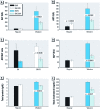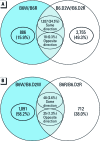Obesity is mediated by differential aryl hydrocarbon receptor signaling in mice fed a Western diet
- PMID: 22609946
- PMCID: PMC3440132
- DOI: 10.1289/ehp.1205003
Obesity is mediated by differential aryl hydrocarbon receptor signaling in mice fed a Western diet
Abstract
Background: Obesity is a growing worldwide problem with genetic and environmental causes, and it is an underlying basis for many diseases. Studies have shown that the toxicant-activated aryl hydrocarbon receptor (AHR) may disrupt fat metabolism and contribute to obesity. The AHR is a nuclear receptor/transcription factor that is best known for responding to environmental toxicant exposures to induce a battery of xenobiotic-metabolizing genes.
Objectives: The intent of the work reported here was to test more directly the role of the AHR in obesity and fat metabolism in lieu of exogenous toxicants.
Methods: We used two congenic mouse models that differ at the Ahr gene and encode AHRs with a 10-fold difference in signaling activity. The two mouse strains were fed either a low-fat (regular) diet or a high-fat (Western) diet.
Results: The Western diet differentially affected body size, body fat:body mass ratios, liver size and liver metabolism, and liver mRNA and miRNA profiles. The regular diet had no significant differential effects.
Conclusions: The results suggest that the AHR plays a large and broad role in obesity and associated complications, and importantly, may provide a simple and effective therapeutic strategy to combat obesity, heart disease, and other obesity-associated illnesses.
Conflict of interest statement
The authors declare they have no actual or potential competing financial interests.
Figures




References
-
- Alexander DL, Ganem LG, Fernandez-Salguero P, Gonzalez F, Jefcoate CR. Aryl-hydrocarbon receptor is an inhibitory regulator of lipid synthesis and of commitment to adipogenesis. J Cell Sci. 1998;111(Pt 22):3311–3322. - PubMed
-
- Baillie-Hamilton P. Chemical toxins: a hypothesis to explain the global obesity epidemic. J Altern Complement Med. 2002;8:185–192. - PubMed
Publication types
MeSH terms
Substances
Grants and funding
LinkOut - more resources
Full Text Sources
Other Literature Sources
Medical

